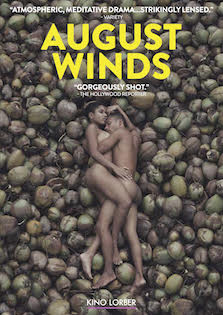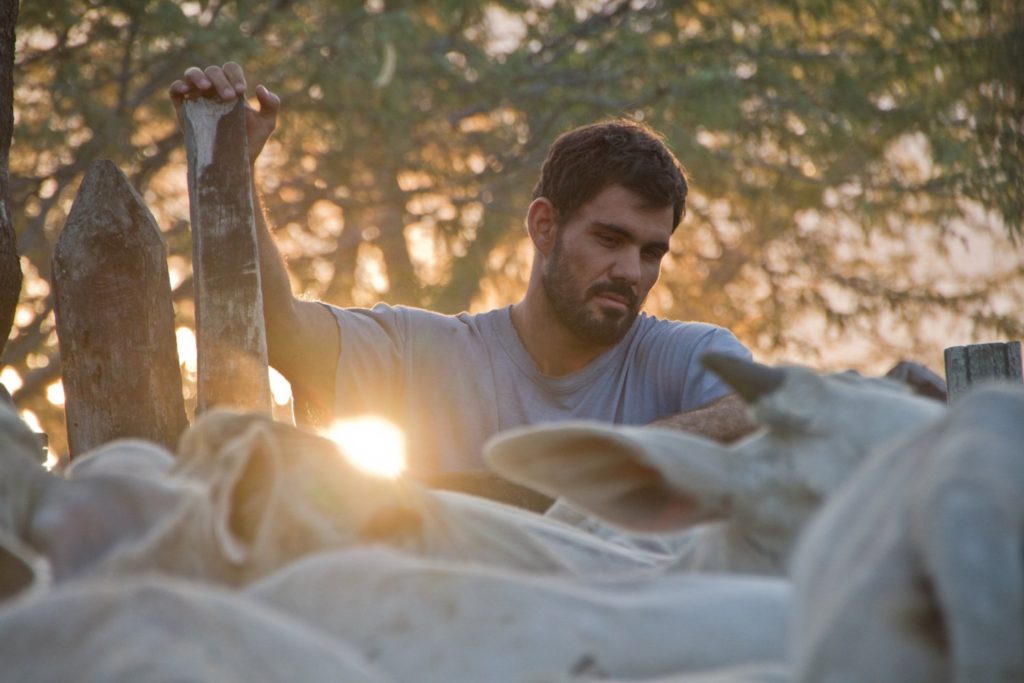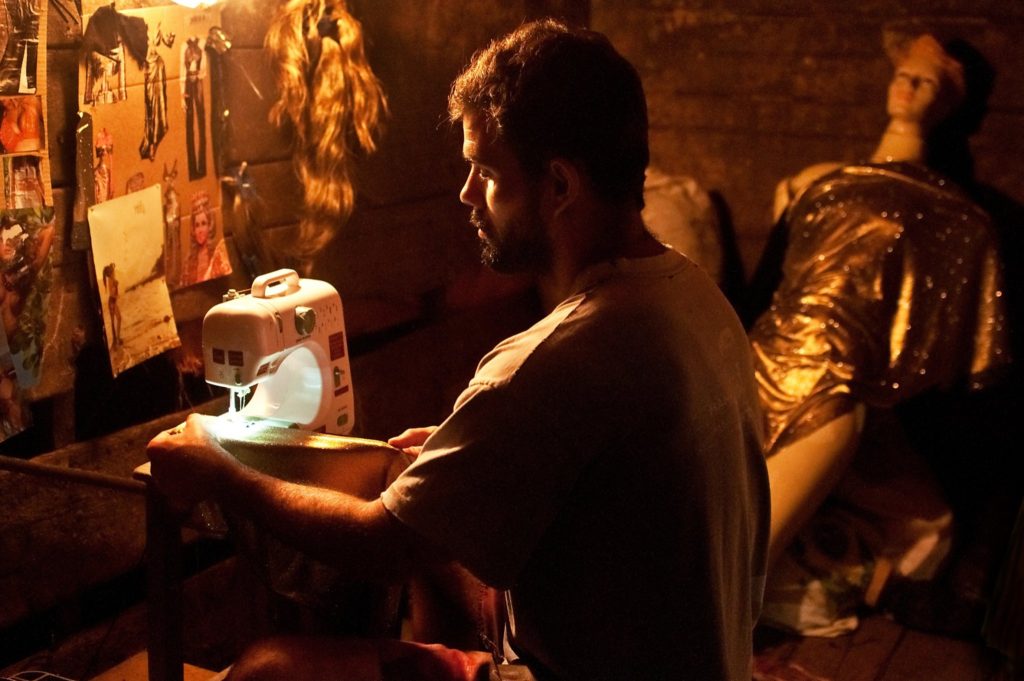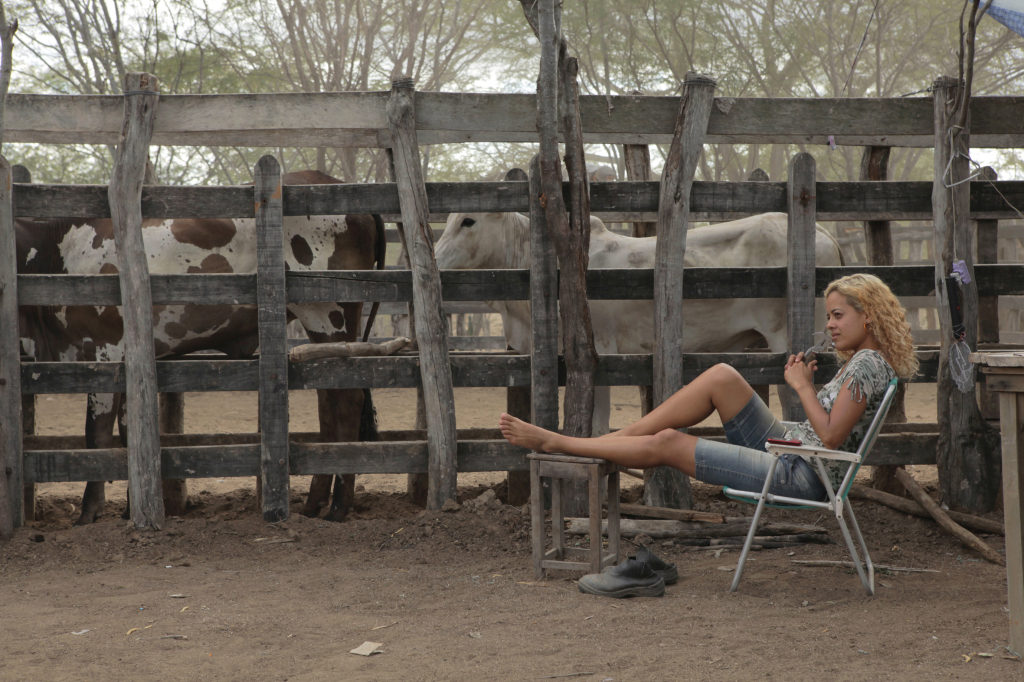Bodies at Rest, Bodies in Motion in Rural Brazil

Award winning filmmaker Gabriel Mascaro.
A slow, living wind is blowing in, and you’ll want to know about it. Young Brazilian filmmaker Gabriel Mascaro, already recognized as a talent for his documentary Housemaids, has recently turned to narrative feature filmmaking, and his emerging voice is like none other. Mascaro is interested in life and all of its beauty and fragility.
His two feature films August Winds (2014) and Neon Bull (2015), are dropping September 6 on blu-ray courtesy of Kino Lorber. Both are immaculate, lush, immediate looks at life in his native country, gripping in their tranquility. Both blu-rays come highly recommend to adventurous and patient devotees of World Cinema, lovers of honest portrayals of naturalism and decay, and those genuinely interested in vividly emerging visionaries on the international filmmaking front. Sensual to their cores, and not without graphic moments to go along with that, it’s little surprise that no cinema chain would commit to booking these films on American soil.
*****
August Winds
DIRECTED BY GABRIEL MASCARO/PORTUGUESE/2014
STREET DATE: SEPTEMBER 6, 2016/KINO LORBER
 “People who die here don’t go to heaven or hell. They go to the sea.”
“People who die here don’t go to heaven or hell. They go to the sea.”
August Winds, a beautifully bleak film from late 2014, details the natural dance of life and death in a small Brazilian coastal village. It is mesmerizing and deliberate in its poetic depiction of day to day life in this environment. Young men shimmy up tall coconut trees, defying gravity as though it’s nothing at all, collecting their bounty into old trailers to be pulled by huffing, puffing SUVs and pickup trucks. Scuba diving and boating are also regular components of ordinary life for these people. One gets the impression that for them, there might as well be no outside world. Their immediate existence, one of tropical storms ravaging shanty life in late summer, is inescapable enough, thank you very much.
Shirley and Jeisen (Dandara de Morais and Geová Manoel Dos Santos, two unprofessional actors that more than get the job done) are typical young lovers with nothing better to do than scuba dive and have sex in the loaded coconut cart. As types, they’re broadly recognizable but also people of few words who are art-film alienated and plagued by unseen weight and realities. But, beneath that – perhaps above it? – they are indicative of life and death themselves. Specifically, she is life, he is death.

August Winds settles honorably into the category of “slow cinema”, in that many scenes consist of one long, unbroken shot captured from a stationary camera, similar to Dietrich Brüggemann‘s more rigidly formal Stations of the Cross or Bela Tarr’s The Turin Horse. Here, death is as predictable as the trade winds themselves – and it comes through not just in the storyline (if one should call it that) but in the filmmaking proper.
Yet, August Winds is never boring. Tranquil and foreign and consistently creatively framed, Mascaro’s film carries the viewer along for its brisk 75 minute running time. Things happen in August Winds, but they are almost beside the point: A skull is found underwater – Who’s is it? A storm recorder succumbs to imminent peril – Will anyone notice? These vignettes, all acted for the camera, play like documentary realism.

*****
Neon Bull
DIRECTED BY GABRIEL MASCARO/PORTUGUESE/2015
STREET DATE: SEPTEMBER 6, 2016/KINO LORBER
 If August Winds marked Gabriel Mascaro’s transition to narrative storytelling, Neon Bull is him bursting from the gate as a here-to-stay force to be reckoned with.
If August Winds marked Gabriel Mascaro’s transition to narrative storytelling, Neon Bull is him bursting from the gate as a here-to-stay force to be reckoned with.
Has there ever been a director more obsessed, more driven to so frankly explore the primal?
One would logically expect a neon bull to generate a significant amount of neon bullcrap. Ironic on some level, then, is the fact that Mascaro leaves that for nearly every other movie ever made, and sticks to “the real”. That’s not to say that his recent highly acclaimed award winning film Neon Bull is a documentary. Like August Winds, it is not. Yet, Mascaro’s documentary roots continue to show through, brightly, innovatively yet plainly.
Neon Bull is often referred to as a “road movie”, as the ensemble of characters, led by aspiring costume designer, Iremar (a fully masculine yet sensitive Juliano Cazarré) travel with their small-time rodeo from town to town in rural Brazil throughout the entire film. Yet, nomadic as these people may be, this is no travelogue. Upon first viewing at least, the towns, villages and marketplaces run together as the plights and dynamics of the fully drawn characters take center stage. There’s a meandering monotony about everything, even as their day’s typically climax with two of the guys galloping out into a ring of their own making to yank a small emaciated-looking bull off its feet for whatever audience they attract. (Would the Humane Society approve Neon Bull? This repeated occurrence is the least of the reasons they wouldn’t.)

The day-to-day rodeo life of trailer hitches, clotheslines, feeding troughs and unending shit to shovel is filmed with such a beautiful balance and artist’s eye that every moment, every sense, is a surprise. Mascaro eeks toward a quicker, more conventional filmmaking in so much as not every sense is one long unbroken shot. His framing is curious, his camera moves are nothing if not intentional, and his visual landscape is all his own. It is all in the service of unpacking Iremar’s fellow characters, who in turn are conceived to show us a side of Brazil the recent network Olympic coverage never would. Struggle doesn’t lead to gold medals and glory, it leads to more struggle. Dreams, be they to one day transcend one’s inglorious occupation for another, or to own a horse, are more burdensome for the dreamer than aspirational most of the time. These are “real people” (characters, though), traversing their land and engaging their own primal natures and daily needs all the while, as they must.
Mascaro’s art, as confrontational, aloof yet emotionally raw, foreign, and fully frontal as it can at times be, may place it more at home in an art gallery rather than a multiplex.
Has there ever been a director more obsessed, more driven to so frankly explore the primal? In his twenty-one minute interview that is included among the disc’s bonus features, Mascaro says that Neon Bull is a film about “body as a place of transformation”. We do see bodies in plain clothes and then later costumes, bodies very pregnant and bodies without clothing. We see animal bodies in flux, bulls being forcibly yanked to the ground by their tails as part of the traveling rodeo, and a male horse becoming very erect, then masturbated.
A porno mag that’s clearly been rendered “sticky” in previous use is repurposed creatively and still later looked upon with social curiosity. A woman gives herself a Brazilian wax in the front seat of a parted truck. Her leg spares is the ugly details, but when she’s inevitably interrupted, it’s not for awkward comic effect like it would be in almost any other movie. No, it’s just her tween daughter looking to borrow some tools. Mascaro’s comment is enlightening to his intentions, although unnecessary. For this viewer, if August Winds is all about the inevitability of death, then Neon Bull is all about being alive. Glowing, ugly, honest, communal alive-ness. As truly uneasy as Neon Bull is, it reaches further than most any film, and pays off greater.

That’s not to say the end is the great pay off. As its already been widely referenced and discussed in most every other conversation of the film, it might as well be revealed here that Neon Bull ends with a bang. “Bang” as in sex. Bang is the wrong word, actually. A male character has sex with a very pregnant woman. The scene plays out in real time, and, it must be said, looks awfully real. Keeping in mind that these are experienced film actors, the “how” of the scene remains a mystery. In his interview, Mascaro talks very much around the mechanics of staging the prolonged, unbroken intimate scene, but mentions the concern the talent had with how it would be realized. Did they or didn’t they? What exactly are we seeing?
In any case, in the context of pure filmmaking, artistic statement, and the lush, sensual way it’s realized from afar is undeniably beautiful, even as its also odd, primal and curious. Mascaro does share that he and his cinematographer discovered that for them, the farther the camera is from their subjects, the more intimate it feels. Somehow, it’s true. As a viewer, being thrust into watching what may well be cinematic sexual intercourse is admittedly off putting. Yet, the familiar tired refrain that movies (and by extension, audiences) glorify violence while shuttering honest sexuality is a legitimate observation.
The fact of it being pregnant sex in Neon Bull somehow lessens the perceived inappropriateness, as it might actually be beneficial to some to see how these characters manage to do the deed with her as far along as she is. In any case, this key moment in the film is what could be called, if there is such a thing, properly prurient: The voyeuristic quality makes for natural discomfort, but it‘s completely not skeezy. Once more, we’re seeing people using their bodies to do what they do.

No bonus features accompany August Winds on the Kino Lorber blu-ray release, aside from its trailer. Neon Bull also has its own trailer, as well as the aforementioned director’s interview (it’s only downside being the absurd length of time each text question hangs on screen before cutting back to him for his answer. Micro-naps can be taken in the interim between reading them and the answer), and a fourteen minute “making of” video, which clarifies once and for all that it is not a documentary of any kind.
Mascaro’s art, as confrontational, aloof yet emotionally raw, foreign (In Portuguese with English subtitles), and fully frontal as it can at times be, may place it more at home in an art gallery rather than a multiplex. Yet, both August Winds and Neon Bull are bona fide cinema in their own earthy, exploratory right. Both have been done right on blu-ray, the next best thing to experiencing them in their native environment: The big screen.
The images in this review are not representative of the actual Blu-rays image quality, and are included only to represent the films themselves.

